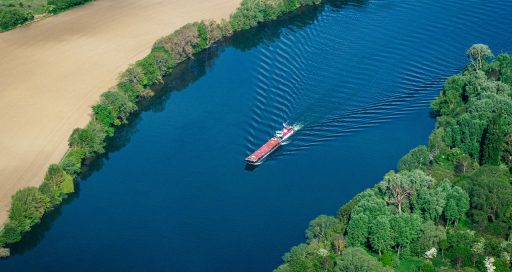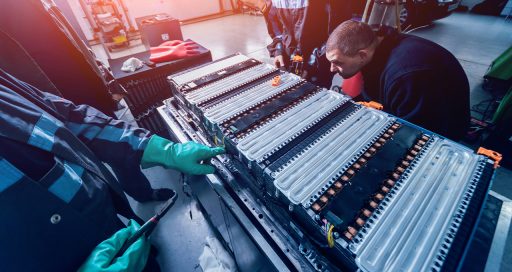There is no shortage of initiatives for decarbonising marine transport. While liquefied natural gas is looking to the future, the true solutions of tomorrow are e-fuels and perhaps… sails?

The European FuelEU Maritime regulation stipulates an 80% reduction in greenhouse gas emissions from shipping fuel by 2050. Against this backdrop, e-fuels appear to be one solution for replacing fuel oil and decarbonising the sector using engine technology similar to that in use today. Various possibilities exist, at different maturity levels, and there is no shortage of initiatives.
Hydrogen: a promising but still-limited solution
Of the various solutions, hydrogen produced using low-carbon electrical energy is no longer a pipe dream but a genuine alternative. “Aside from the fact that the only by-product of burning hydrogen as fuel is water, its real strength is that it contains three times more energy than natural gas,” explains Nicolas Dattez, Hydrogen Development Director at VINCI Energies, who is responsible for coordinating hydrogen projects at Leonard, the VINCI group’s future-oriented innovation platform.
However, he adds, “Because its density is so low, to store and transport it requires high-tech solutions and costly processes to liquefy or compress it and keep it in that state.”
For the time being, LNG (liquefied natural gas) appears to have a role to play in reducing the carbon impact of maritime transport, but the sector will be hard pressed to achieve its 2050 targets without recourse to hydrogen.
E-fuels are a way to decarbonise ships without the need to revolutionise current propulsion technologies.
Compressed hydrogen could certainly be used in small craft making short journeys, and projects abound in this field. The Europe Technologies group’s Hylias (Hydrogen for Land, Integrated renewables and Sea) project aims to create the first-ever ship powered by two 250 kW electric motors, with two fuel cells and 350 to 400 kg of hydrogen stored on board in 350‑bar high-pressure vessels.
In addition, the use of liquid hydrogen is perfectly feasible for ships travelling moderate distances, such as some ferries. In March 2023, the Norwegian operator Norled introduced its first liquid hydrogen ferry. More than 80 metres long, this ship uses two 200 kW hydrogen cells and a 1.36 MWh battery pack powered by green hydrogen stored at a temperature of minus 252.87 °C.
From biomethanol to wind propulsion
But what about huge vessels like container ships? These are less well-suited to the use of pure hydrogen.
“It is extremely difficult to store the quantity of hydrogen needed for these long voyages in either a compressed or liquid state,” says Nicolas Dattez. “So, you have to consider other solutions, including hydrogen derivatives such as ammonia, e-methanol or e-methane.”
He continues, “All three compounds can be produced from green hydrogen using renewable energy sources, but the last two also require carbon dioxide (CO2).” Unfortunately, the infrastructure for producing these synthetic fuels has yet to be built. In the meantime, methanol or methane can be synthesised from biomass, and in that context are generally referred to as biomethanol and biomethane.
Here too, initiatives are flourishing. In September 2023, the Danish shipping company Maersk launched its first biomethanol-powered ship and has ordered five more.
Similarly, the French shipping and logistics company CMA CGM and the energy giant Engie forged a partnership in 2021 with the aim of producing and distributing greener fuels to help decarbonise maritime transport. Liquid biomethane is one avenue they are working on as part of the drive to develop a low-carbon fuel production and distribution sector for maritime transport. CMA CGM’s fleet should include 44 LNG-powered ships by the end of 2024.
In a very different vein, wind propulsion, long since left behind by merchant shipping, is back as a potential future solution for international maritime transport. The Michelin group has developed Wisamo, an inflatable sail hoisted and lowered on a telescopic mast. Recognised by the Solar Impulse Foundation in July 2023, this technology can be used with any type of ship thanks to a high-performance inflatable sail system.
“Ultimately, the simplest way to reduce ships’ per-kilometre fuel consumption is to reduce their speeds,” concludes Nicolas Dattez.
“There is no single comprehensive solution”
Bruno Nicolas, Actemium Brand Director, discusses “new fuels” and how competitive they are.
What are currently the most competitive “new fuels”?
In the short term, LNG, which is still a fossil fuel, can help reduce CO2 and particulate emissions. It is also a way to transition to greener biofuels and e-fuels, which will be usable without modifications to existing engines and fuel tanks on ships designed for LNG.
You’re speaking in the future tense…
Biofuels are already being produced in small quantities at a reasonable cost and should enable us to comply with our 2030 incorporation obligations. But e-fuels are still in the pre-industrialisation phase. They are more costly to produce due to the cascading returns, and require plentiful low-carbon electricity.
What are the factors affecting the competitiveness of these new fuels?
The competitiveness of e-fuels compared with fossil fuels depends on three factors: investment cost, the availability of cheap low-carbon electricity, and carbon taxation. A combination of biofuels and e-fuels is one suggested solution to make unit prices more competitive. The adoption of stringent international standards (through the International Maritime Organization) combined with national government incentives is essential for accelerating energy efficiency improvements in maritime transport.
What are the most promising solutions in the longer term?
There is no single comprehensive solution. Only a combination of different solutions will make it possible to achieve the stated objectives. The result will depend heavily on our capacity to produce and distribute low-carbon alternative fuels.
Solutions for phasing out fuel oil
- Electricity: suitable for shorter distances, because of the volume of batteries to be carried.
- Hydrogen: virtuous when produced using renewable energies, but difficult to store and transport.
- E-ammonia: cheap, easy to store, but highly toxic.
- Biomethane: produced from the methanisation of biomass, this gas has limited production capacity.
- Biomethanol: biofuel produced from biomass.
- Other synthetic or e-fuels (e-methane, e-methanol, etc.): easily usable in place of current fuels, but production is still in its infancy, and they remain expensive.
- Nuclear: zero greenhouse gases and a high degree of autonomy, but there are safety concerns.
- Wind: has the lowest carbon impact, but does require engines as backup.
04/16/2024





